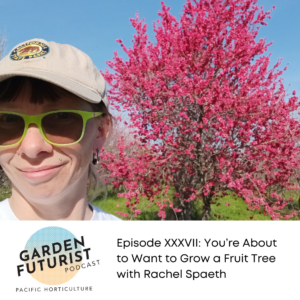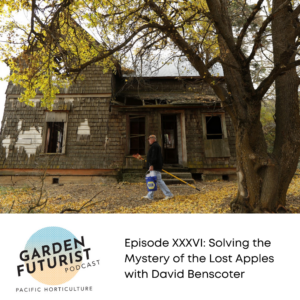
The Moss Garden at Bloedel Reserve

Contributor
“Each part of the soil is sacred in the estimation of my people. Every hillside, every valley, every plain and grove, has been hallowed by some sad or happy event and when the last Red Man shall have perished… these shores will swarm with the invisible dead of my tribe… and when your children’s children think themselves alone in the field, the store, the shop, upon the highway, or in the silence of the pathless woods, they will not be alone… At night when… you think them deserted, they will throng with the returning hosts that once filled and still love this beautiful land.”
Farewell Speech of Chief Seath of the Suquamish Indians, Bainbridge Island, 1855
Frances Trollope angered Americans in the 1830s with the critical account of her travels here, but the book is as interesting, today, for its descriptions of landscapes — the “magnificent” rhododendrons, azaleas, and mountain laurel of the Alleghanies, or the profusion of flowers that seemed like a “second spring” in the autumn woods of Maryland. And forests. Forests so numerous she came to call them “wearisome” and finally said those of Tennessee, Indiana, and Ohio were the worst: their tight canopy prevented undergrowth, “which [is what] makes the ‘eternal forests’ of America so detestable… leaves that have been rotting since the flood… cover the ground and infect the air.”
The civilized way with forest has always been to clear it, drain it, and open it for use, tasks that were well underway a century ago in the Pacific Northwest. So it is amazing that a 140-acre tract on Bainbridge Island in Puget Sound escaped development (apart from being logged over in the 1870s), especially since it had been platted into two-and-one-half-acre lots by 1904, the year Angela Collins, a Seattle businessman’s widow, purchased it. She later built the main house and planted a collection of rhododendrons, leaving the surrounding woods untouched.

When Prentice and Virginia Bloedel purchased the Collins property in 1951, they took a deliberative pace with plans for the land. The Bloedel Reserve archives contain architects’ drawings of monumental staircases, golf courses, and ponds for fishing and boating — all predictable trappings of display, and all of them rejected. Instead, the couple explored the land and learned from their discoveries, as Prentice Bloedel recalled in 1980:
In the course of [our] forays we found the land itself marvelously varied… We found single plants and colonies of fragile woodland species, mosses, ferns, a world of incomparable diversity… We found that plants often have a way of arranging and disposing themselves with a harmony of color, texture and form when left to themselves.
Respect for the natural environment made Bloedel determined to develop the property with a subtlety, a “humility,” suited to the native forest. He said the work of Otto Holmdahl, the first landscape designer, was too formal and despite a long association with the San Francisco landscape architect Thomas Church, Mr Bloedel found his work “too much architecture, too little nature.” It was Fujitaro Kubota who created the Japanese gardens.
These and many other professionals joined in the dialogue about the Bloedel land, but the task of shaping these ideas, beginning in 1980, fell to Richard Haag, Seattle landscape architect and founder of the department of landscape architecture at the University of Washington. For the Bloedel design Haag received the President’s Award of Excellence from the American Society of Landscape Architects (ASLA), in May 1986, and became the first person to have the award twice (the first was for his Gas Works Park in Seattle, in 1981).
The award was not without irony, for that same spring the first of Haag’s garden rooms, the Garden of Planes, was replaced; since, changes in the plantings and even the route through the gardens — for maintenance and trail management — were made by the firm hired to open Bloedel Reserve to the public. As Susan Rademacher Frey wrote in the article that announced Haag’s award in Landscape Architecture, “what are the implications if even the best of a profession’s work is susceptible to such loss, or what is the recourse when decision makers refuse to recognize that a place can carry such richness of meaning?”
Notes from ASLA design jurors reflect the wonder at what Haag had created for the Bloedel Reserve. They said how in “other designs… when you strip away that first superficial layer there’s nothing left. In this one you get the sense that if you strip it away… there are [still] layers upon layers upon layers of meaning.” Another juror noted the interplay of human order and natural order, and another mused “you really have to go to an older culture to see something of this quality.”
Haag created four garden rooms to be visited in a sequence in which an almost geometrically sparse area is followed by a totally natural one, and where it is clear that “nature” is being used as a cleansing process, in the sense of stripping away extraneous or distracting elements. The first, the garden of planes, used sculpted mounds of gravel within a courtyard formed of random squares of moss and concrete; the second, the Anteroom, is a bog hum which underbrush has been cleared and ferns and mosses planted. This leads to the Reflecting Garden, a rectilinear reflecting pool of ground water 200 feet long, surrounded by closely mowed turf and a meticulously trimmed ten-foot yew hedge. The fourth area is a bird sanctuary, with islands created as habitats for waterfowl and migratory birds and which is meant to celebrate “the cycle of nature and man’s ability to create life-sustaining environments.”
My work on the horticultural uses of mosses took me to the Bloedel Reserve in August 1988, and as I stood in the anteroom I realized how superfluous had been my previous concerns about moss gardens — about transplanting mosses and learning to identify them correctly. The understatement and simplicity of the garden room, and especially the anteroom, is remarkable. As another ASLA juror noted:
The thing I keep coming back to is… how simple the means are and how much has been achieved… [yet the gardens] are simple in different ways. For instance the great water court is nothing but two rectangles one inside another, but it is magical… The [anteroom] uses fallen logs, things are called up that normally one would clear away… but they… are brought in and made part of a composition [yet] you can’t see the hand that made it… [T]he last one is nature and yet by the time you’re there, you’ re set up to see it as something special. It would be invisible if you came upon it without this preparation and without this sequence.
The bird sanctuary had become “creative nature,” that juror concluded, and this is also true of the anteroom. The wider paths, the richly varied undergrowth, and a break of sunlight through the trees all result from the “selective subtractions” by which Haag shaped the garden, working in the field the better part of a year with the reserve’s crew. One walks slowly and carefully into the lowered light of this area. It comes to seem an almost primordial space, so it is difficult to accept as the work of humans, but a theory of circulation Haag published in 1980 suggests the techniques involved.

Haag wrote that “a direct relationship exists between slowing movement through an environment and enriching the quality of the sensory perception of that environment;” he adds that this is especially true of the multistoried, coniferous rain forest of the Pacific Northwest. Also, “a finite space seems larger the more slowly one moves through it,” so that, “by carefully preserving the detail and nuances of the woods…slowness is assured, thereby assuring an intimate look at Nature.” In the anteroom, the circulation sequence past trees and stumps and logs slows one’s passage, and ensures that the rich native undergrowth will be noticed closely.
One enters this moss garden by what Frey calls a “mutely powerful trail with the cushioned velvet of moss underfoot. A log already attacked by lichens decays near the path, knit to the ground by the same enveloping carpet of moss. Ancient stumps stand next to living trees, punctuating the space and anchoring it in memories of what Haag calls these “ghosts of trees,” remnants of the virgin forest that would now be 600 or 700 years old. But the richly decaying bases of these dark pedestals are alive with new life, and from their recesses spring woodland species of huckleberry, salmonberry, ferns, and salal.
The conifers that dominate this space, adding a soaring, cathedral-like dimension to the shaded, shadowed garden of mosses, are the giant native arborvitae, Thuja plicata; western hemlocks, Tsuga heterophylla; and the larches, Larix occidentalis. There are birches, alders, and Aralia as well as the native Sitka mountain ash, Sorbus sitchensis and S. scopulina. Also thickly planted is devil’s club, Opolopanax horridus, the special favorite of Prentice Bloedel that thrives in wet woodlands (and is named for the impaling qualities of its spines).

While the moss floor of the anteroom seems as old as the tallest trees, these bryophytes have grown together to cover what Richard Haag describes as a “nursery planting” of 2,200 trays of Irish moss (which is not a true moss but a vascular plant), plugs of which were set out for the mosses to grow over. Since mosses are natural colonizers but selective about habitat, this nursery technique is an extremely good way to establish moss in any shaded area (as improbable as that may seem to gardeners who want only to eradicate moss, but in the right situations it can be a ground cover of great merit).
The brochure prepared for the Bloedel Reserve exhibit at the Architectural League of New York said Haag’s garden rooms reflect different relationships with the surrounding natural landscape, “creating a place for human beings to reflect on their relationship with nature.” No concern about staking or length of bloom intrudes, and it may be this absence of what we strive for in traditional gardens that gives natural places their great sense of serenity. These places help one see land as it really is, in order to work in harmony with it — a special challenge now that symptoms of climate change appear each season. The regional use of native plants, which have always had great (if generally unrecognized) aesthetic merit, has become the best horticultural solution to problems of drought and warming — as the western states are now teaching the rest of the country. But to be content with native landscapes also means freeing oneself from landscape values one has been taught to emulate — values often as out of place as Frances Trollope in the wilderness. Visits to gardens such as the anteroom help us recognize the beauty and essential simplicity of our native landscapes.
Share:
Social Media
Garden Futurist Podcast
Most Popular
Videos
Topics
Related Posts

Ground Up Science for Greener Cities with Garden Futurist Dr. Alessandro Ossola
Spring 2023 Listen to the Podcast here. Alessandro Ossola is a scientist who gets very excited about the challenge of climate change allowing for an

Readying Urban Forests for Climate Realities with Garden Futurist Dr. Greg McPherson
Winter 2023 Listen to the Podcast here. “Going from the mow and blow to a more horticulturally knowledgeable approach to maintaining the landscape. And that

Low Maintenance Gardens – Better for Pollinators and People
Autumn 2022 “I come out every day. It’s therapy, my meditation.” Janet’s young garden transformed from overgrown, invasive plants to mostly natives. The dailiness of

Invasive Plants Are Still Being Sold: Preventing Noxious Weeds in Your Landscape
Autumn 2022 With so many beautiful ornamental plant species and cultivars throughout California and the Pacific Northwest, how do you decide which ones to include










Responses